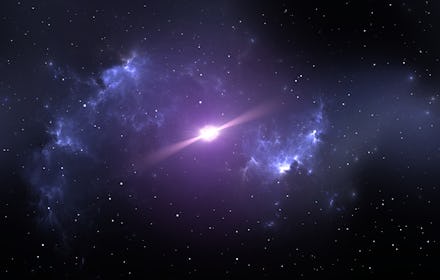Scientists just discovered a star so massive it pushes the limits of physics

Not all stars become a black hole when they reach the end of their life. Sometimes, when the core of an enormous star collapses, the remains become densely packed matter. The strength of its gravity crushes protons and electrons together, creating neutrons, and turns the mass into a 'neutron star.' Astronomers still don't know a lot about neutron stars, but a team of researchers with the NANOGrav Physics Frontiers Center recently reported on a finding that has brought mankind another step closer to understanding these unusual creations. They observed the existence of the largest neutron star scientists have ever found.
Generally, neutron stars are around the same size as a city, and made up of matter "packed so tightly," according to NASA, "that a sugar-cube-sized amount of material would weigh more than [one billion] tons." And this newly discovered astronomical body is 2.14 times the mass of the sun. This discovery pushes the limit of how large and dense a mass can be without becoming a black hole.
The neutron star, called J0740+6620, has been classified as a 'pulsar.' This basically means it emits a beam of radio waves from each magnetic pole like lighthouse beacons. Pulsars also tend to spin rapidly "with some spinning faster than a kitchen blender," states NASA on its website.
While making observations using the Green Bank Telescope, located in West Virginia, the team of researchers spotted both a white dwarf star and the neutron star nearby. By measuring the white dwarf — the less dense corpse of a dead star — and the neutron star's interactions with each other, the team could measure the size of the neutron star.
This measurement is done thanks in part to, once again, Albert Einstein's theory of general relativity. Per his theory, gravity around the dwarf star is slightly warped as these masses orbit each other. This alters the pulses emitted by J0740+6620 — an occurrence named the "Shapiro Delay" after the astrophysicist Harvard University professor Irwin Shapiro. The team was able to use the altered pulses to estimate the size of the white dwarf, and then use that measurement to calculate the mass of the enormous neutron star.
The discovery of the largest neutron star known to mankind is no small feat. Dense masses like J0740+6620 can help scientists understand how huge neutron stars can possibly be before they succumb to gravity and become black holes.
"Neutron stars have this tipping point where their interior densities get so extreme that the force of gravity overwhelms even the ability of neutrons to resist further collapse," explained astronomer Scott Ransom, co-author of the study, to Science Daily. "Each 'most massive' neutron star we find brings us closer to identifying that tipping point and helping us to understand the physics of matter at these mindboggling densities."